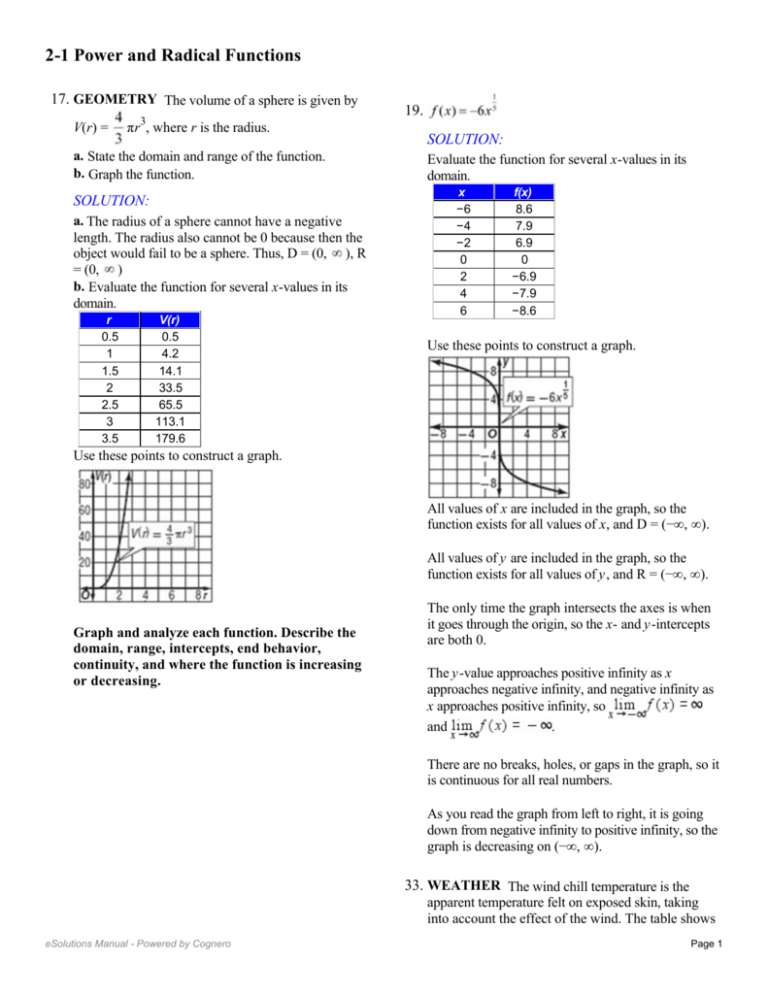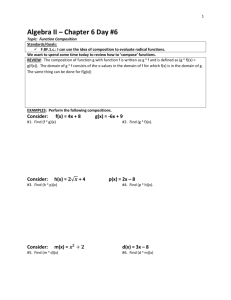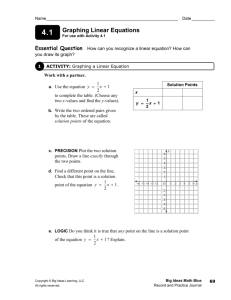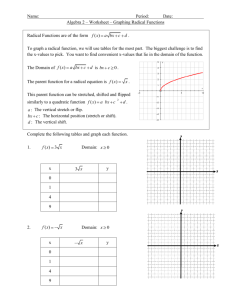2-1 Power and Radical Functions
advertisement

Graph and analyze each function. Describe the domain, range, intercepts, end behavior, continuity, and where the function is increasing or decreasing. 2-1 Power and Radical Functions 17. GEOMETRY The volume of a sphere is given by V(r) = 3 πr , where r is the radius. a. State the domain and range of the function. b. Graph the function. 19. SOLUTION: Evaluate the function for several x-values in its domain. x −6 −4 −2 0 2 4 6 SOLUTION: a. The radius of a sphere cannot have a negative length. The radius also cannot be 0 because then the object would fail to be a sphere. Thus, D = (0, ), R = (0, ) b. Evaluate the function for several x-values in its domain. r 0.5 1 1.5 2 2.5 3 3.5 V(r) 0.5 4.2 14.1 33.5 65.5 113.1 179.6 f(x) 8.6 7.9 6.9 0 −6.9 −7.9 −8.6 Use these points to construct a graph. Use these points to construct a graph. All values of x are included in the graph, so the function exists for all values of x, and D = (−∞, ∞). All values of y are included in the graph, so the function exists for all values of y, and R = (−∞, ∞). Graph and analyze each function. Describe the domain, range, intercepts, end behavior, continuity, and where the function is increasing or decreasing. 19. SOLUTION: Evaluate the function for several x-values in its domain. x −6 −4 −2 0 2 4 6 f(x) 8.6 7.9 6.9 0 −6.9 −7.9 −8.6 There are no breaks, holes, or gaps in the graph, so it is continuous for all real numbers. As you read the graph from left to right, it is going down from negative infinity to positive infinity, so the graph is decreasing on (−∞, ∞). 33. WEATHER The wind chill temperature is the eSolutions Powered Cognero UseManual these -points tobyconstruct The only time the graph intersects the axes is when it goes through the origin, so the x- and y-intercepts are both 0. The y-value approaches positive infinity as x approaches negative infinity, and negative infinity as x approaches positive infinity, so and . a graph. apparent temperature felt on exposed skin, taking into account the effect of the wind. The table shows the wind chill temperature produced at winds of Page 1 various speeds when the actual temperature is 50ºF. graph is decreasing on (−∞, ∞). 33. WEATHER 2-1 Power and The wind chill temperature is the Radical Functions apparent temperature felt on exposed skin, taking into account the effect of the wind. The table shows the wind chill temperature produced at winds of various speeds when the actual temperature is 50ºF. c. Graph the regression equation using a graphing calculator. To predict the wind chill temperature when the wind speed is 65 miles per hour, use the value function from the CALC menuon the graphing calculator. Let x = 65. The wind chill temperature when the wind speed is 65 miles per hour is about 39.54°F 42. FLUID MECHANICS The velocity of the water a. Create a scatter plot of the data. b. Determine a power function to model the data. c. Use the function to predict the wind chill temperature when the wind speed is 65 miles per hour. SOLUTION: a. Enter the data into a graphing calculator and create a scatter plot. flowing through a hose with a nozzle can be modeled using V(P) = 12.1 , where V is the velocity in feet per second and P is the pressure in pounds per square inch. a. Graph the velocity through a nozzle as a function of pressure. b. Describe the domain, range, end behavior, and continuity of the function and determine where it is increasing or decreasing. SOLUTION: Evaluate the function for several x-values in its domain. P 0 1 2 3 4 5 6 b. Use the power regression function on the graphing calculator to find values for a and b. V(P) 0 12.1 17.1 21 24.2 27.1 29.7 Use these points to construct a graph. −0.0797 f(x) = 55.14x . c. Graph the regression equation using a graphing calculator. To predict the wind chill temperature when the wind speed is 65 miles per hour, use the value function from the CALC menuon the graphing calculator. Let x = 65. eSolutions Manual - Powered by Cognero The wind chill temperature when the wind speed is 65 miles per hour is about 39.54°F b. Since it is an even-degree radical function, the domain is restricted to nonnegative values for the radicand, P. Thus, P ≥ 0. D = [0, ) Page 2 The velocities include nonnegative values, so R = [0, ) is continuous on [0, 2-1 ). As you read the graph from left to right, it is going up from 0 to positive infinity, so the graph is increasing on [0, ∞). b. Since it is an even-degree radical function, the Power and Radical Functions domain is restricted to nonnegative values for the radicand, P. Thus, P ≥ 0. D = [0, ) The velocities include nonnegative values, so R = [0, ) Solve each equation. 46. −3 = − SOLUTION: The velocity approaches infinity as pressure . approaches infinity, so There are no breaks, holes, or gaps in the graph, so it is continuous on [0, ). Now isolate the remaining radical. As you read the graph from left to right, it is going up from 0 to positive infinity, so the graph is increasing on [0, ∞). Solve each equation. 46. −3 = − SOLUTION: Now isolate the remaining radical. Since the each side of the equation was raised to a power, check the solutions in the original equation. x = 13 x= 1.75 Since the each side of the equation was raised to a power, check the solutions in the original equation. x = 13 One solution checks and the other solution does not. Therefore, the solution is x = 13. Solve each inequality. 66. SOLUTION: eSolutions Manual - Powered by Cognero x= 1.75 Page 3 One solution checks and the other solution does not. 2-1 Therefore, Power and Radical the solution is x =Functions 13. Solve each inequality. 66. SOLUTION: Since each side of the equation was raised to a power, check for extraneous solutions. Choose a number from the possible solution set, say x = 24. Since the root is even, the function must be checked for restrictions on the domain. The radicand, 6 + 3x, must be greater than or equal to 0. Solve 6 + 3x ≥ 0 for x. Since the solution does not account for this restriction, it must be added to the solution. Therefore, the solution is −2 ≤ x ≤ 25. eSolutions Manual - Powered by Cognero Page 4








